Nerja Revisited
The caves at Nerja came highly recommended as a place NOT to miss (thank you Sue) so, rather than taking the usual A45 highway into Malaga, we plotted a back route via the 7204 and A356 through the hills, villages and valleys … past hillsides draped in the ever-present olive trees, their shadows in the morning sun making them look like knobbly green bedspreads … and down into Vélez-Málaga before connecting with the N340 along the coast. A much more scenic route … and it avoided busy Malaga. The area around Vélez-Málaga is ALL citrus trees … nary an olive to be seen.
We’d packed sandwiches for lunch, planning to find a park or a vacant bit of beach to eat them – no such luck. Nerja is an attractive but holiday-based town, and busy – so not many parking places anywhere near the waterfront. We did, however, find a very pleasant tree-lined gravel parking lot on one of the side streets, and munched our food in the shade while birds chirped in the branches above.
Taking the coast road, the caves were just 5 minutes north in Maro, and we almost had the place to ourselves. https://www.visit-andalucia.com/guide-to-nerja-caves/ Discovered in 1959 by some teenagers looking for bats while on an evening hike, these caves are jaw-droppingly awesome and I defy anyone to find an adequate description. We stood as insignificant tiny dots in the hushed, dimly lit vastness of a cavern that dwarfed most cathedrals … the staggering number, size and GIRTH of the calcified stalactites and stalagmites … and sometimes you don’t know which because they meet and reach floor to roof. Solid limestone waterfalls … pillars … arches … chandeliers …spires … all frozen in eons of time. Surely Gaudi must have visited such a place to gain inspiration for his Sagrada Familia . . . the resemblances are remarkable. However this cave was discovered much later than Gaudi’s time. It is reputed to contain the largest stalactite in the world. If you get a chance, DO visit.
A little north of the pretty and unspoiled pueblo of Maro, a cliff road wound down to a protected sandy cove. We joined the line of parked cars parked along the steep verge and ambled down. It was longer and steeper than it looked. A sprinkling of people lounged on rented sunbeds under grass umbrellas, or had brought their own sunshades and beach blankets . . . there were a few colourful kayaks for rent . . . kids were swimming, and an occasional snorkeler drifted by. This was far removed from the noise and bustle of more popular Costa beaches. We sat in the shade and enjoyed the ambiance for a couple of hours. Glen, feeling the need to at least paddle his toes in the Mediterranean, rolled up his shorts a bit and cautiously padded over the hot, pebbly sand. All was fine, until a slightly larger wave rose higher than expected and soaked the lower half of his shorts. Nothing a walk along the beach and a lounge in the sun couldn’t handle.
We thought we had found yet another way home via back roads . . . it certainly was scenic, but it meandered further and further from the direction we wanted . . . then the gas gauge took a sudden plunge and the warning light came on. Hmmm … didn’t we we pass a gas station back there a bit? It had looked closed and deserted – an Agri-coop … wonder if that means it only has farm gasoline? … but no – there was the sign for gasolina 95 sin plomo. This, however, was quite unlike any usual gas/petrol station . . . consisting of a shiny metal cubical with pump-handles both sides, and completely automated – you paid ahead using a computerized screen (thankfully, language of choice could be selected) . . . AND it was about €0.15/litre cheaper than in town.
We ended up going back the way we came, but this time were able to get a better view of the dam and reservoir – Embalse de la Viñuela … this is the first time we’ve seen the extent of the drought this summer. Levels in the reservoir resemble those in California with ‘tide marks’ getting progressively lower and lower … the pumps now barely reaching what’s left of the lake. We’d just driven past lots for sale … advertising water-front property … that now isn’t. It’s sad to see, but a relief that the olives and orange trees are thriving though.
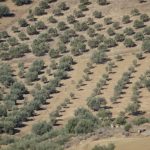

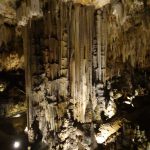
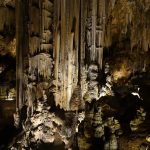

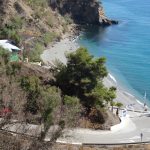

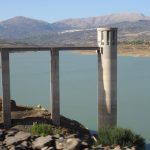
2 Comments
Tim
I’d not been to the Cuevas en Nerja. They certainly look spectacular.
The water levels are disturbing.
Jennifer Smith
I’ve not come across any mention of water levels rising as the consequence of floods/rain … eg the cave in Thailand … but it would probably be prudent to avoid in heavy downpours.